What Other Fish Can Live With African Cichlids
Who can resist the telephone call of the cichlid tank?
The sheer diversity of colors and patterns combined with the activity levels and character of these fish draws aquarists to pursue this setup.
The well-known claiming with cichlids is managing their temper.
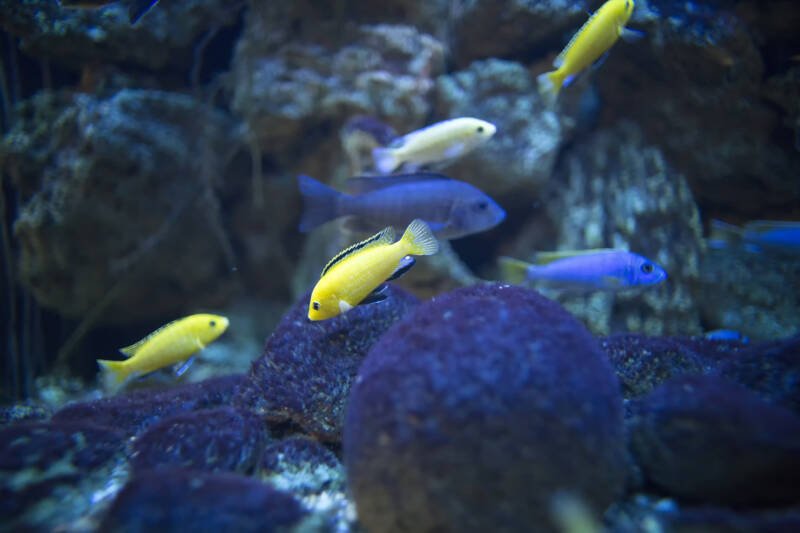
Many, simply non all, cichlid species tend to be aggressively territorial, which can brand it hard to select tank mates.
Often, aquarists choose a single-specimen or unmarried-species tank. While that is a workable solution, others want a multi-species tank.
How do yous choose?
Types of African Cichlids
First, acquire all you can most your African cichlid.
Nearly African cichlids come from one of three lakes in the Rift Valley.
This is important to know because the h2o atmospheric condition for each lake differ slightly, and that can bear upon the tank mate you select.
Lake Malawi

Lake Republic of malaŵi has a massive number of cichlid species.
This sandy bottom lake ranges in temperature from 76 to 82°F (24-28°C) and has a pH of 7.4 to 8.4.
Species include the peacock cichlid and the brilliantly colored electrical yellow and blue cichlids.
Sizes of these fish range widely from as minor as 3 inches to as large as 10 (7-25 cm).
These fish tend to be more aggressive and require rock work and cave features in their habitat.
Lake Tanganyika
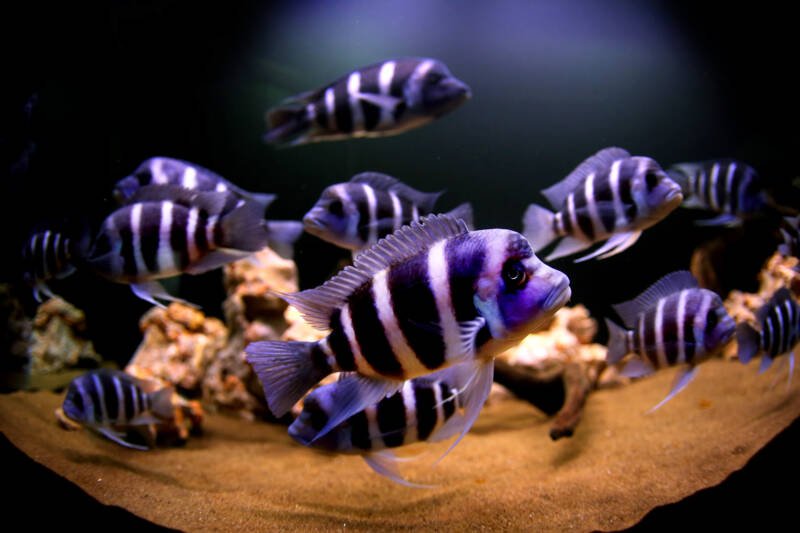
This lake features a rocky, sandy bed, with temperatures varying from 72 to 82°F (22-28°C) and pH from 7.8 to ix.0.
This pH range makes it slightly more challenging to pair fish from these waters as any tank mates need to tolerate this amount of alkalinity.
Republic of malaŵi lake also boasts ane of the smallest African cichlids, the shell dweller, which barely reaches two inches (5 cm), equally well as the massive, foot-long (xxx.five cm) frontosa cichlid.
Lake Victoria
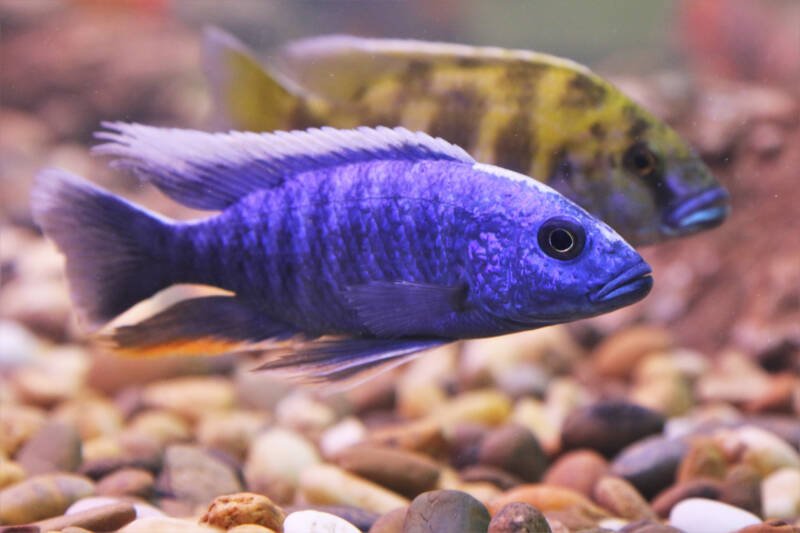
Lake Victoria is a shallow lake with a rocky bottom.
Temperatures are slightly cooler, ranging from 70 to 81°F (21-27°C), and the pH sits between seven.two and 8.six.
There are numerous Haplochromis species residing in these waters.
They are vibrantly colored and range in size from three to 5 inches (7-13 cm).
Some are peaceful while others tin readily concur their ain in a tank of more aggressive fish.
Outside of the Rift Valley
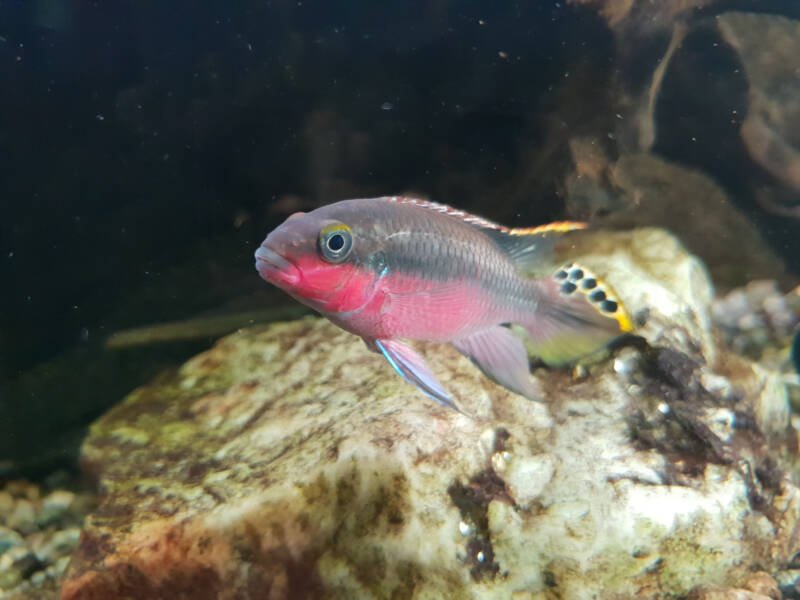
Numerous cichlid species inhabit other lakes, rivers, and waterways.
As you can imagine, the water conditions vary and some of these species favor neutral or acidic waters.
One of the nearly popular of these species is the kribensis cichlid.
This river-abode fish from Nigeria and Cameroon tolerates h2o pH ranges from every bit low as v.0 to as loftier every bit viii.0.
Other lake dwellers come from neutral, soft waters, such as those from Lake Bermin or Barombi Mbo.
Managing Behavior
Once yous have selected your ideal pairing, it is all about behavior management.
Give them space
Cichlids need space, and so do not skimp on tank size.
Smaller species tin go by with a 20-gallon tank, only 30 gallons is better.
For each fish you lot add to the mix, plan on an additional three to v gallons (minimum) of water.
Keep water parameters stable
Cichlids take specific h2o requirements.
When selecting tank mates, choose those uniform with the cichlid's needs rather than trying to brand information technology work the other way around.
Many cichlids are already prone to ambitious behavior and stressing them with poor water conditions will exacerbate the situation, leading to an unhappy tank at best or ill/injured fish at worst.
Feed them well
One way to proceed your cichlid happy, and by extent less ambitious, is by ensuring it has a steady, nutritional diet.
Food scarcity is one of the chief drivers for assailment. Cichlids run the gamut of nutritional needs.
Many are omnivorous and love a care for of fresh or frozen brine shrimp, while others are strictly carnivores or herbivores.
Feed your cichlid two to three times a day and no more than than they can finish within two minutes.
Plan your tank setup
Cichlids enjoy excavation, plus many of their ideal tank mates are lesser dwellers, so a sandy substrate with rock features is safe.
Fish similar to access hiding places, and decorations break up the line of sight to reduce conflict.
Live plants are acceptable, but brand certain at that place is adequate swimming space.
Selecting Tank Mates
When choosing a fish to pair with your African cichlid, look for fish that are:
- Larger, peaceful lesser dwellers
- Fast swimming schooling or shoaling fish
- Fish from the same expanse, lake, or water conditions
- Fish of the same size and temperament.
Avoid the post-obit:
- Fish with unlike water needs, such as corys, clown loaches, and American cichlids: practice not try to force fish with differing needs together. Yous volition negatively impact the health of your tank.
- Small, peaceful fish, such as the kuhli loach, tetras, guppies, and kribensis: these will be far too tempting for your cichlid, who will view them as a snack.
- Closely related African cichlids that could brood and produce unwanted hybrids
- Slow swimming fish or those that do non exercise well with excessive activeness, such as angelfish.
The following are some of our favorite fish to pair with African cichlids.
Recommended African Cichlids Tank Mates
1. Plecos
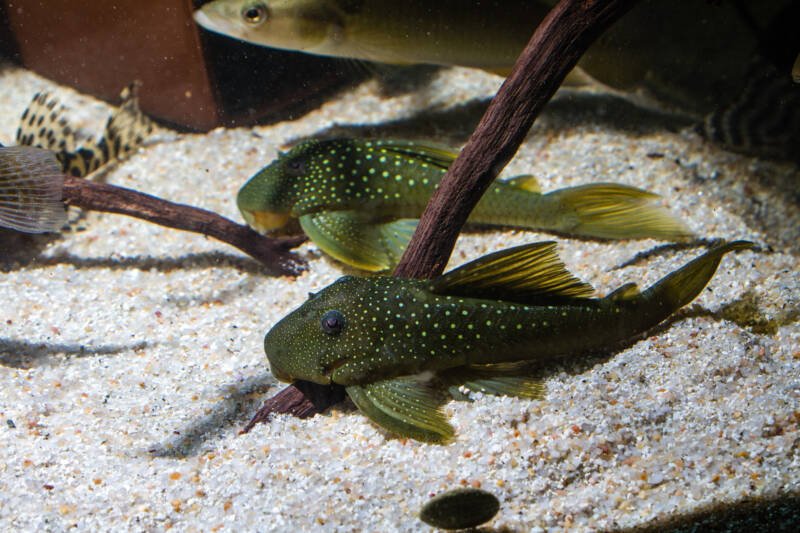
Minimum Tank Size: 150 gallons
Common plecos are easy-going, large bottom dwellers that will stay out of a cichlid's way.
These nocturnal algae eaters need sinking foods, fed on a unlike schedule, to complete their nourishment.
Their size necessitates a big tank equally common plecos can achieve up to 24 inches (61 cm) in length.
Fancy plecos are significantly smaller every bit adults and tin work with cichlids if they are larger in size when introduced.
While the h2o temperature needs of the 2 species overlap well (near plecos like 72 to 78°F or 22 to 26°C), the pH for most cichlids is slightly over the upper limit of the pleco (6.5 to seven.5).
2. Other African Cichlids
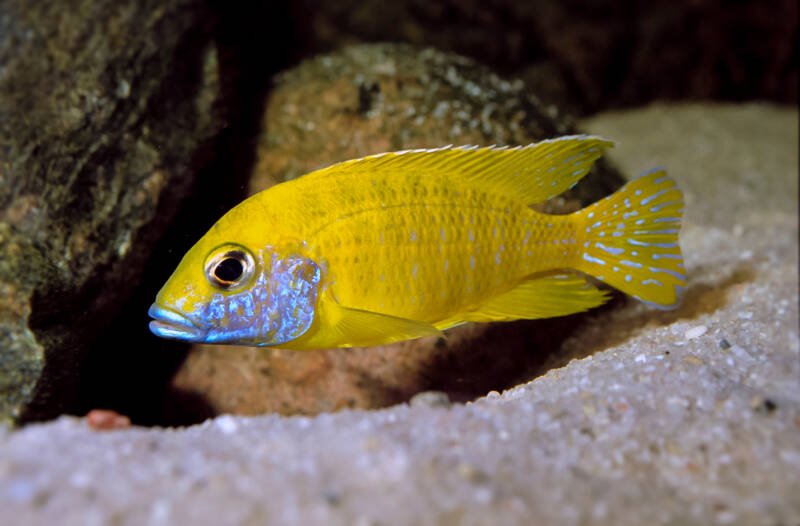
Minimum Tank Size: thirty gallons
In general, yous cannot go wrong in pairing an African cichlid from one lake with another cichlid species found in that same lake.
You are guaranteed to have matching water weather, which makes that part of the equation unproblematic.
Always research the beliefs of the individual species earlier pairing them and look for potential incompatibilities that would provoke assailment, such every bit the species looking besides similar.
As nosotros have mentioned, do not pair closely related species that could mate and produce unwanted hybrids.
iii. Zebra Loach (Botia striata)

Minimum Tank Size: 30 gallons
The zebra loach is some other lesser-abode pick.
It is a small species, maxing out at three to four inches (7-10 cm), and then make certain that you innovate larger zebras and then that the cichlids do not consider them food.
Zebras demand to be kept in a group of at least five for them to be confident and healthy.
Smaller groups could consequence in stress and assailment amidst the loaches.
Overall, they tend to keep to themselves and make adept tank mates.
Water temperature needs match well but keep the pH toward the upper stop of the loach'southward range to friction match with the cichlid.
For some cichlid species, the pH needed will be higher than the loach's upper range.
4. Red Tail Shark (Epalzeorhynchos bicolor)
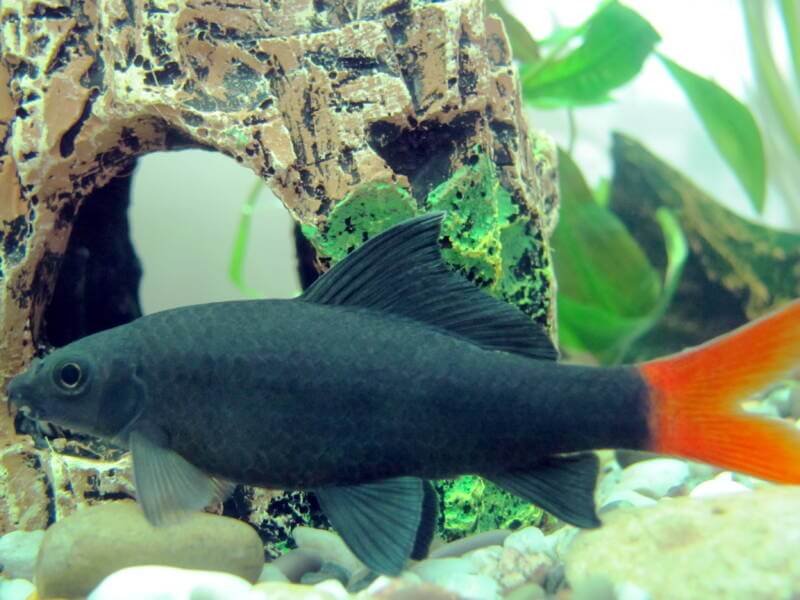
Minimum Tank Size: 55 gallons
Sticking with the theme of bottom dwellers, consider the blood-red tail shark.
These bi-colored fish take a striking appearance with a dark, black body and contrasting bright red tail.
They reach anywhere from four to six inches in length (10-xv cm), making them a good fit with your cichlid size-wise.
Their activity level is high, which should not present a trouble provided the tank is large enough for the ruby tail and cichlid to have their own territories.
To ameliorate continue the peace, go along only one red tail in the tank, as they will readily go after whatsoever other fish that looks similar them.
5. Paratilapia (Paratilapia polleni)
Minimum Tank Size: 55 gallons
The paratilapia is a cichlid species native to Madagascar.
Males grow to an impressive 11 inches in length (28 cm), while females attain one-half that.
They live in water conditions ranging from cold to hot, element of group i to acidic, and fresh to brackish.
Their ideal conditions match the warm, alkaline, and hard water favored by African cichlids.
This fish can be aggressive toward others of its kind, and so keep it as a unmarried specimen or a monogamous pair.
Add plenty of hiding spaces that break the line of sight and allow territory establishment.
This species is listed every bit "vulnerable" on the IUCN Red List. Purchase captive-bred specimens to protect native populations.
vi. Gem Cichlids (Hemichromis bimaculatus)

Minimum Tank Size: 40 gallons
The adjustability of this Westward African species makes information technology an excellent friction match for Rift Valley cichlids, especially the peacock and Haplochromis.
They enjoy the same warm water conditions; however, the pH will demand to be on the upper cease of the precious stone'due south tolerance. Keep the hardness under 12 dGH.
Jewels tend toward aggression, which can worsen if you have a breeding pair.
This six-inch-long species (15 cm) can impale larger fish than itself if it is stressed, underfed, or overstocked.
Monitor any pairing, ensure a large habitat, and include decorations to break up the line of sight.
vii. Giant Danios (Devario aequipinnatus)
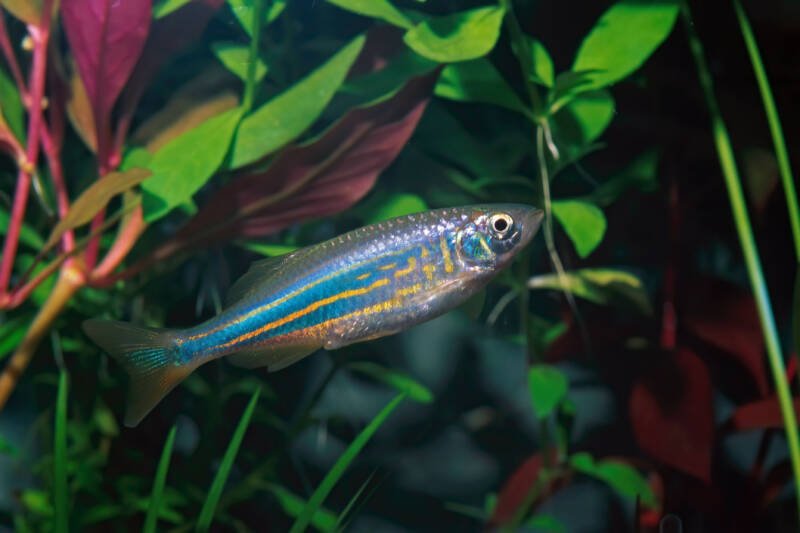
Minimum Tank Size: 55 gallons
Giant danios bring movement, character, and interest to a cichlid tank.
Their schooling beliefs can also assist calm aggression in your cichlids.
Danios' near comfortable and playful activeness comes when they are kept in a schoolhouse of eight to 10 fish.
They prefer the heart to bottom areas of the tank.
Make certain the danios are large when you lot innovate them to avoid having the cichlids view them every bit food.
Your danios should grow to an adult size of 5.nine inches (xv cm), then plan on a large, long tank with moderate current flow to conform them.
viii. Rainbows (Melanotaeniidae)
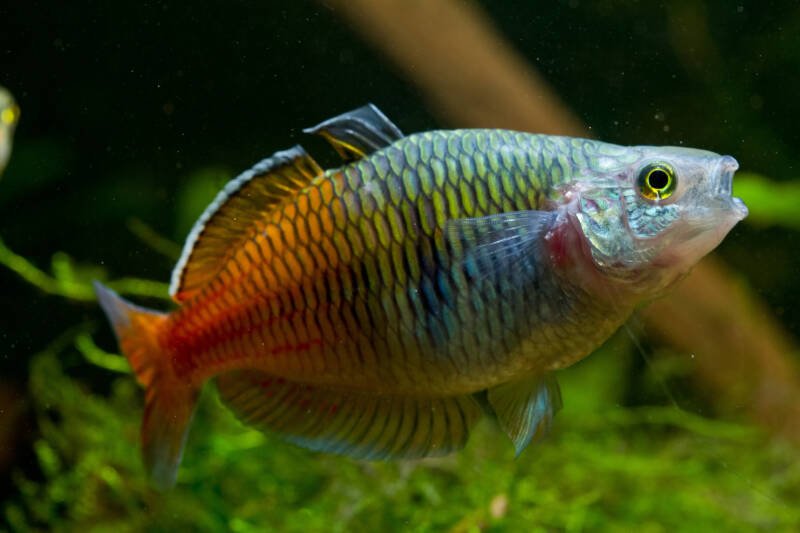
Minimum Tank Size: 10 – 50 gallons, depending on the species
Rainbows include four sub-families – each with slightly dissimilar water needs.
Almost of these fish love the same warm, hard, alkaline water equally practise the African cichlids.
Nevertheless, there are some that exercise amend in slightly more acidic water, then verify their needs before purchasing.
These shoaling fish exercise best in groups of half-dozen or more, prefer the top one-third of the tank, and take healthy appetites.
Select a rainbow species that is approachable in behavior. Shy species will not do well in a cichlid tank.
Introduce larger rainbows to the tank every bit smaller fish may go lunch for your cichlids.
9. Lake Malawi Synodontis (Synodontis njassae)
Minimum Tank Size: thirty gallons
This Synodontis is endemic to Lake Malawi waters.
Pairing information technology with cichlids from those very same waters ensures common parameters.
This 7.vi-inch (19 cm) omnivore is nocturnal and will be active when your cichlids are resting and hiding in caves during the mean solar day.
Synodontis prefer to stick close to the bottom of the tank, using their sensitive barbels to experience their way around.
This fish does well with other active fish. Brand certain that your cichlids are large enough that the Synodontis will not fault them for food.
Exercise not pair other Synodontis species with Southward. njassae as that may atomic number 82 to aggression.
10. Siamese Algae Eater (Crossocheilus siamensis)

Minimum Tank Size: xxx gallons
Another gentle bottom dweller from Southeast Asia, the Siamese algae eater is not only a favorable community tank fellow member that will not provoke your cichlid, but they also help keep the tank clean by feeding off algae.
These fish are in constant motion along the tank bottom.
They reach an adult length of six inches (15 cm) and need room to swim and places to hide.
Siamese algae eaters adopt slightly more acidic h2o than do nigh African cichlids.
Pair them with cichlids that can tolerate a neutral pH.
11. Flying Fox Fish (Epalzeorhynchos kalopterus)
Minimum Tank Size: 100 gallons
The upper terminate of the flying fob's pH range overlaps with cichlids that tolerate ranges closer to 7.0, which limits your choices.
For Lake Tanganyika species, the pH is out of range.
This Southeast Asia native grows to a decent size of six inches (15 cm) and needs a massive tank.
These fish practice well in a community tank with species that do not expect like them.
However, they are highly territorial and volition fight any fish in their space.
Do non house them with their own kind, other bottom dwellers, or like species, such as Labeo sp. every bit the flying flim-flam will consider them targets.
12. African Red-Eyed Tetra (Arnoldichthys spilopterus)

Minimum Tank Size: fifty gallons
A larger tetra species, the African scarlet-eyed tetra reaches an adult length of four inches (10 cm).
Not only practice they pair well with African cichlids due to their size, but they also favor identical h2o conditions and like food sources.
Cherry-eyed tetras are highly active, so should not be kept with any shy species.
This activity level, however, will not bother your cichlid and may aid deter assailment every bit the schoolhouse swims in the open h2o.
A school of 10 fish is ideal as it will bring out their best behavior. They will occupy all levels of the water column.
13. Murray River Rainbowfish (Melanotaenia fluviatilis)
Minimum Tank Size: xxx gallons
The only Australian native on our listing, the Murray River rainbowfish is a hardy species that inhabits a wide range of aquatic environments.
They tolerate a broad range of pH values from every bit low as six.5 to as high as eight.5, and then check the location from which your rainbowfish comes to make certain their water parameters are uniform with your cichlid'southward.
These omnivores reach a length of iv inches (10 cm), which matches well with many African cichlid species.
They are fast, active, and should exist kept in a grouping of at to the lowest degree six.
Pair them with gentle-tempered cichlids for the best upshot.
Closing Thoughts
There are many things to consider when choosing a tank mate for your African cichlid.
Well-matched water parameters, temperament, and behavior patterns all come into play.
In one case you take the pairing of your choice, ensuring optimum tank size and setup, stable conditions, and quality nutrition lead toward a peaceful and enjoyable tank.
With a plan in listen, you tin can successfully build your dream cichlid tank!
We would love to hear from you! What is your dream cichlid tank?
erskineantiver1986.blogspot.com
Source: https://fishtankadvisor.com/african-cichlid-tank-mates/
0 Response to "What Other Fish Can Live With African Cichlids"
Post a Comment